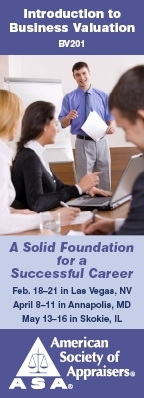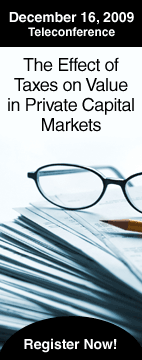
| Alerding anticipates resurgence in community The number of transactions involving community banks and financial institutions should increase significantly in the next three to five years, according to Jim Alerding, who spoke on this niche topic at the most recent AICPA National BV Conference in San Francisco. “It may not happen right away, because of the current economy,” he said, “but it will happen.” Banking shareholders are getting older (along with most of the business-owning population), and many are waiting for built-in capital gains deadlines to expire. “Once that rolls off,” Alerding said, “most banks will be ready to sell.” Of course, more sellers on the market drives down the prices of community banks, he cautioned. Because of the higher regulatory burdens and costs of doing business in the current economy—and greater concerns about asset quality—most buyers will bargain hard for lower prices, to protect their shareholders. How can valuation analysts—and their bank clients—prepare to get the best price in the coming sale days? Alerding offered this advice:
Market approach is most reliable. When valuation time comes, the market approach may prove the most reliable. Transaction data are plentiful: “There’s a lot more data on banks in the transaction databases such as Pratt’s Stats,” Alerding said. He also recommended Austin Associates for “all kinds of industry-specific resources on deal value,” including bank and thrift M&A transaction data since 2004. Beaton’s new guide to 409A valuations clarifies standards Who else can make valuing early stage companies look cool and cutting edge? At last month’s ASA Fair Value Summit in San Francisco, Neil Beaton presented the topic in a mock turtleneck and a portable microphone, looking like “Steve Jobs at an Apple shareholders’ meeting,” according to ace reporter Josh Cashman (Arcstone Partners), who attended the event. Beaton was not just making an effort to elevate the hipness of the BV profession. “He’s establishing clear work-product standards,” Cashman says, in particular by publishing BVR’s Guide to Valuations for IRC 409A Compliance, available for pre-order now. The new Guide specifically addresses the three traditional valuation methods (an income approach should evaluate the path to profitability; the market approach must incorporate a “back-solve;” and the cost approach is generally not relevant). It also discusses when to use an OPM or PWERM (or an overlay of both), and how to handle and/or capture:
Ultimately, the Guide underscores the fact-intensive inquiry of early-stage valuations and helps the analyst apply good judgment and analysis. “Everything is driven by the circumstances, particularly in such complex matters,” Beaton told ASA attendees. “So much depends on factors such as the strength of the company, the strength of investors, the nature of the industry, and the cycle in the economy.” Will this litigation expert ever testify again? One of the bank’s experts did not fare so well. He testified under oath that “no court had ever found his methodology to be unreliable” or failed to adopt his solvency opinion. Subsequent testimony revealed, however, that at least two courts rejected his methods and/or ultimate opinion. With his attorney’s help, the expert tried to distance himself from these cases (it depends on your definition of “ultimate”), but the TOUSA court found his “dissembling… extraordinarily troublesome.” More troubling still, the expert “swore” in a deposition that he’d reviewed an internal company memo before coming to his conclusions, and then testified at trial that he’d never seen the document. “Such a fundamental contradiction about a crucial document…served only to erode [his] overall credibility further,” the court said. It was left with the distinct impression that the expert’s testimony “on this and many other points was simply unbelievable and that, for the right price, [he] would opine as desired on anything.” Better lessons in the remaining 186-pages. The remainder of the court’s lengthy opinion analyzes all of the expert valuation opinions in painstaking detail, including their reliance on DCF/asset analyses by third party real estate appraisers; their range of discount rates; reliance on observable market inputs; sources of historical cost data; use of management forecasts; and selection of company comparables. Read the complete digest of the TOUSA bankruptcy case in the January 2009 Business Valuation Update™, and the full-text court opinion at BVLaw™. To tax-affect or not to tax-affect...? New research on the real impact of taxes in private markets may surprise you Get a preview. Next Wednesday, December 16th Fannon will host “The Effect of Taxes on Value in Private Capital Markets”, a 100-minute, BVR teleconference based on her Guide and its compilation of the latest academic research and analysis. To find out more—and to get a free copy of the Introduction to Fanon’s Guide, click here. The conference kicks off at 10:00am PT/1:00pm ET; two CPE credits available. New FASB releases on financial instruments, investment funds Last week the Financial Accounting Standards Board (FASB) posted a summary of its constituent outreach in connection with its project on Accounting for Financial Instruments, documenting its input from various investors, preparers, regulators, and valuation specialists. The staff also posted a summary on How the FASB Obtains and Considers Investors’ Perspectives in Setting Accounting Standards, discussing many ways investors are engaged in the standard setting process and how the Board communicates their perspectives. More recently, this week the FASB issued its Proposed Accounting Standards Update, Consolidation (Topic 810): Amendments to Statement 167 for Certain Investment Funds. The proposed amendments would defer Statement 167 requirements for certain investment company interests—e.g., mutual funds, hedge funds, mortgage REITs, PE and VC funds (but not securitization entities, asset-backed financing firms, etc.). The Board invites responses to four particular questions, including whether respondents generally agree with the deferral of 167 requirements and whether its definition of affected entities is sufficiently clear. Written comments to this Exposure Draft are due by January 6, 2010; instruction on how to send by email and mail (but not by fax) are highlighted on page 1 of the Update. Don’t miss free webinar on industry research with BizMiner Take advantage of a free, one-hour webinar on how to mine and apply BizMiner reports in your next business valuation engagement, sponsored by BVResources and presented by Jon Brandow (founder of BizMiner). Brandow will demonstrate how to drill down into discrete types of businesses and target the best geographic area for your subject company—right down to the zip code, if need be. Join us on Friday, December 11th at 10am Pacific time, 1pm Eastern time for this informative, free event. One CPE credit is available. U.S. Supreme Court unlikely to find PCAOB unconstitutional If the justices decide the accounting board is unconstitutional, however it could force Congress to revisit Sarbanes-Oxley and question the independence of other government agencies, says the Wall Street Journal. The court’s decision may turn on the input of Justice Kennedy, who questioned whether the president’s recommendations to an independent agency are appropriate. Stay tuned…
To ensure this email is delivered to your inbox, Copyright © 2009 by Business Valuation Resources, LLC
|
|
|



